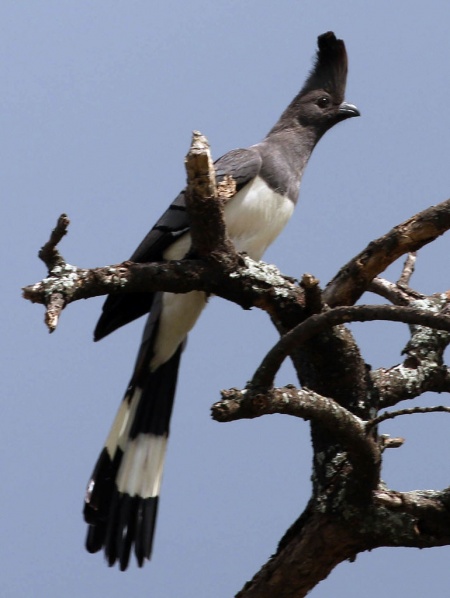| (5 intermediate revisions by 3 users not shown) | |||
| Line 1: | Line 1: | ||
| + | [[Image:TZP WhiteBelliedGoaway NGO9267.jpg|thumb|450px|right|Photo © by {{user|mikemik|mikemik}} <br />Ngorongoro, [[Tanzania]], May 2017]] | ||
| + | ;[[:Category:Crinifer|Crinifer]] leucogaster | ||
| + | ''Corythaixoides leucogaster'' <br /> | ||
| + | ''Criniferoides leucogaster'' | ||
| − | |||
| − | |||
| − | |||
==Identification== | ==Identification== | ||
| − | + | 50 cm (19¾ in) | |
| + | *Grey overall plumage | ||
| + | *White belly and undertail [[Topography#General Anatomy|coverts]] | ||
| + | *Brownish-grey crest | ||
| + | *Long, pointed grey and black tail with a white median band | ||
| + | *White wing patch | ||
| + | *Back bill in male, pea-green in the female | ||
==Distribution== | ==Distribution== | ||
| − | [[ | + | '''Eastern Africa''': [[Sudan]], [[South Sudan]], [[Ethiopia]], [[Somalia]], [[Kenya]], [[Uganda]] and north-eastern [[Tanzania]]. |
==Taxonomy== | ==Taxonomy== | ||
| − | + | [[Image:White-bellied Go-away-bird2.jpg|thumb|350px|right|Photo © by {{user|xcellent|xcellent}} <br />Tsawo West NP, [[Kenya]] ]] | |
| + | This is a [[Dictionary_M-S#M|monotypic]] species<sup>[[#References|[1]]]</sup>. | ||
==Habitat== | ==Habitat== | ||
Well wooded areas and savanna. | Well wooded areas and savanna. | ||
==Behaviour== | ==Behaviour== | ||
| − | The diet | + | ====Diet==== |
| − | + | The diet consists of fruits, berries, plantains, seeds, flowers, buds and particularly young seed pods of Acacias. | |
| − | + | ====Breeding==== | |
| − | + | Their nest is a twiggy platform The clutch contains 2-3 bluish-green eggs which are incubated by both adults for about 28 days; they also both care for the young who fledge about 10-12 days later. | |
| + | ==References== | ||
| + | #{{Ref-Clements6thOct23}}#Avibase | ||
| + | #Handbook of the Birds of the World Alive (retrieved Sept 2018) | ||
| + | {{ref}} | ||
==External Links== | ==External Links== | ||
{{GSearch|Corythaixoides+leucogaster}} | {{GSearch|Corythaixoides+leucogaster}} | ||
| + | <br /> | ||
| + | {{GSearch|Criniferoides+leucogaster Use Criniferoides leucogaster to}} | ||
| − | [[Category:Birds]][[ | + | [[Category:Birds]] [[Category:Crinifer]] |
Latest revision as of 08:26, 18 December 2023
- Crinifer leucogaster
Corythaixoides leucogaster
Criniferoides leucogaster
Identification
50 cm (19¾ in)
- Grey overall plumage
- White belly and undertail coverts
- Brownish-grey crest
- Long, pointed grey and black tail with a white median band
- White wing patch
- Back bill in male, pea-green in the female
Distribution
Eastern Africa: Sudan, South Sudan, Ethiopia, Somalia, Kenya, Uganda and north-eastern Tanzania.
Taxonomy
This is a monotypic species[1].
Habitat
Well wooded areas and savanna.
Behaviour
Diet
The diet consists of fruits, berries, plantains, seeds, flowers, buds and particularly young seed pods of Acacias.
Breeding
Their nest is a twiggy platform The clutch contains 2-3 bluish-green eggs which are incubated by both adults for about 28 days; they also both care for the young who fledge about 10-12 days later.
References
- Clements, J. F., P. C. Rasmussen, T. S. Schulenberg, M. J. Iliff, T. A. Fredericks, J. A. Gerbracht, D. Lepage, A. Spencer, S. M. Billerman, B. L. Sullivan, and C. L. Wood. 2023. The eBird/Clements checklist of Birds of the World: v2023. Downloaded from https://www.birds.cornell.edu/clementschecklist/download/
- Avibase
- Handbook of the Birds of the World Alive (retrieved Sept 2018)
Recommended Citation
- BirdForum Opus contributors. (2024) White-bellied Go-away-bird. In: BirdForum, the forum for wild birds and birding. Retrieved 5 June 2024 from https://www.birdforum.net/opus/White-bellied_Go-away-bird
External Links





